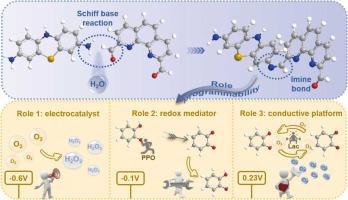Programmable Redox Behavior of a π-Conjugated Schiff Base Mediator across Electrocatalytic and Enzymatic Catechol Sensing Platforms
IF 3.7
1区 化学
Q1 CHEMISTRY, ANALYTICAL
引用次数: 0
Abstract
Redox-programmable mediators enable context-adaptive signal transduction in electrochemical biosensors. We report a π-conjugated Schiff-base mediator (PT) formed by condensing thionine with 1,10-phenanthroline-2,9-dicarbaldehyde; the phenothiazine donor and phenanthroline acceptor create a rigid, electronically delocalized scaffold. PT switches function with potential and enzymatic context: (i) an oxygen-reduction electrocatalyst at -0.6 V following a two-electron pathway; (ii) a redox relay in a polyphenol oxidase (PPO) sensor at -0.1 V, mediating o-benzoquinone–electrode transfer and achieving a 9.79 nM LOD; and (iii) a conductive matrix for laccase at +0.23 V that preserves O2 turnover, affording high selectivity and a wide linear range (1 μM-3 mM; LOD = 0.821 μM). Mechanistic data confirm that the applied bias and enzyme identity dictate PT’s operative role, evidencing molecular-level adaptability. This π-engineered framework provides a general route to tunable electron mediation and multi-mode catechol sensing across electrocatalytic and enzymatic interfaces.

一种π共轭希夫碱介体在电催化和酶促儿茶酚传感平台上的可编程氧化还原行为
氧化还原可编程介质使电化学生物传感器中的上下文自适应信号转导成为可能。本文报道了一种由硫氨酸与1,10-菲罗啉-2,9-二乙醛缩合而成的π共轭希夫碱介体(PT);吩噻嗪供体和吩菲罗啉受体形成一个刚性的、电子离域的支架。PT开关的功能与电位和酶的环境有关:(i)在-0.6 V下的氧还原电催化剂,遵循双电子途径;(ii)在多酚氧化酶(PPO)传感器中设置-0.1 V的氧化还原继电器,介导邻苯醌电极转移并实现9.79 nM的LOD;(iii) +0.23 V下漆酶的导电基质,保持O2的周转,具有高选择性和宽线性范围(1 μM-3 mM, LOD = 0.821 μM)。机制数据证实,应用偏倚和酶的特性决定了PT的操作作用,证明了分子水平的适应性。这个π工程框架提供了一个通用的途径,可调谐的电子中介和多模式儿茶酚传感跨电催化和酶的界面。
本文章由计算机程序翻译,如有差异,请以英文原文为准。
求助全文
约1分钟内获得全文
求助全文
来源期刊

Sensors and Actuators B: Chemical
工程技术-电化学
CiteScore
14.60
自引率
11.90%
发文量
1776
审稿时长
3.2 months
期刊介绍:
Sensors & Actuators, B: Chemical is an international journal focused on the research and development of chemical transducers. It covers chemical sensors and biosensors, chemical actuators, and analytical microsystems. The journal is interdisciplinary, aiming to publish original works showcasing substantial advancements beyond the current state of the art in these fields, with practical applicability to solving meaningful analytical problems. Review articles are accepted by invitation from an Editor of the journal.
 求助内容:
求助内容: 应助结果提醒方式:
应助结果提醒方式:


